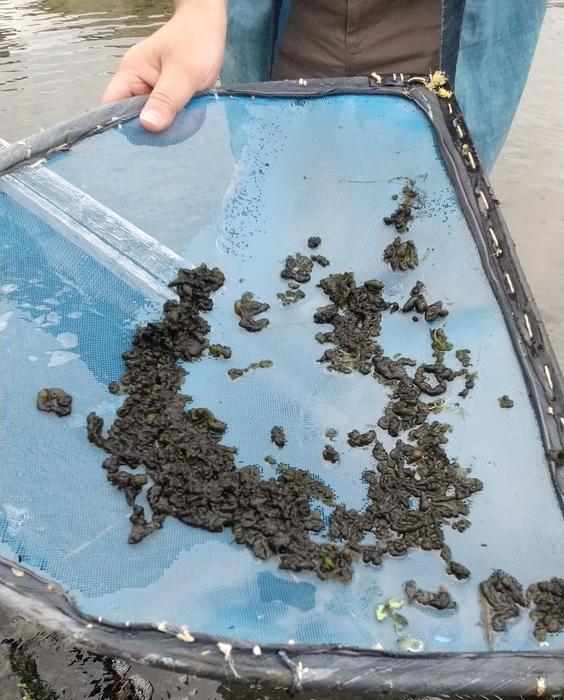The cosmetics industry is turning towards natural alternatives to chemical agents used in products to pave way towards a more sustainable future. Researchers are searching for nature-derived active ingredients for skincare products through extensive bioprospecting research. In this regard, cyanobacteria, with their remarkable metabolic capacity, are a promising source of such agents. Having existed on Earth for nearly 3.5 billion years, these photosynthetic organisms have adapted to various environmental conditions, including extreme environments. Aphanothece sacrum, a cyanobacterium endemic to Japan and cultivated as a food source on farms in Fukuoka Prefecture, is already being studied for the capacity to produce active ingredients like sacran, a water retaining polysaccharide.

Credit: Hakuto Kageyama
The cosmetics industry is turning towards natural alternatives to chemical agents used in products to pave way towards a more sustainable future. Researchers are searching for nature-derived active ingredients for skincare products through extensive bioprospecting research. In this regard, cyanobacteria, with their remarkable metabolic capacity, are a promising source of such agents. Having existed on Earth for nearly 3.5 billion years, these photosynthetic organisms have adapted to various environmental conditions, including extreme environments. Aphanothece sacrum, a cyanobacterium endemic to Japan and cultivated as a food source on farms in Fukuoka Prefecture, is already being studied for the capacity to produce active ingredients like sacran, a water retaining polysaccharide.
Now, a team of researchers, led by Professor Hakuto Kageyama from Meijo University, Japan, have discovered two novel compounds—saclipin A and saclipin B—produced by in A. sacrum. The researchers were originally evaluating environmental stress tolerance mechanisms in cyanobacteria and exploring whether A. sacrum contained mycosporine-like amino acids (MAAs), which can absorb UV radiation and possess antioxidative and antiglycative properties, when they chanced upon the discovery of the two types of saclipins. When asked about his motivations for pursuing the research, Prof. Kageyama explains, “Presently, most UV-absorbing ingredients are chemically synthesized. They pose a significant environmental risk and can inhibit the growth of organisms like seaweed and corals. Natural ingredients will go a long way in improving the environmental credentials of cosmetics and pharmaceuticals as industries pursue ways to be more environmentally conscious.” The team’s findings were published in the Journal of Agricultural and Food Chemistry on 10.1021/acs.jafc.3c05152.
To study the cyanobacterial metabolites, the team needed to isolate them from A. sacrum cells. First, the researchers prepared an organic extract from dried A. sacrum and examined it for UV-absorbing compounds. Next, they purified target metabolites with absorption spectra close to 320 nm, a wavelength falling within the bandwidth for UV radiation. Finally, mass spectroscopy and nuclear magnetic resonance were used to determine the chemical structure of the purified compounds. Touching on the significant findings from the study, Prof. Kageyama says, “Structurally, the saclipins were completely different from known UV-absorbing compounds derived from cyanobacteria, such as MAAs and scytonemin. They absorbed UV radiation, scavenged damaging oxygen free radicals, and inhibited the glycation of collagen and elastin. Taken together, these characteristics show they have the potential to slow down aging.” By exposing A. sacrum to various environmental stressors to understand the growth conditions that induced its synthesis, the team determined that saclipin production was enhanced under drought stress. Additionally, they found a unique property of the saclipins—photoisomerization. Saclipin A could be converted to saclipin B under fluorescent light irradiation. This property is advantageous because it allows for quick adjustment of saclipin ratios in product formulations, depending on the intended use.
Prof. Kageyama is keen to conduct further research on the saclipins. “A. sacrum is cultivated as a food source in Japan. If we can understand how to produce the saclipins at scale, there is the potential to develop them as an edible anti-aging supplement,” he says. He is hopeful that further research will draw attention towards the conservation of this freshwater cyanobacterium. “Such findings could serve as the catalyst for broader conservation efforts. Sustainable aquaculture production could go a long way to securing A. sacrum’s future,” he concludes.
Journal
Journal of Agricultural and Food Chemistry
DOI
10.1021/acs.jafc.3c05152
Method of Research
Experimental study
Subject of Research
Not applicable
Article Title
Sustainable Cosmetics: Harnessing Cyanobacteria for Natural Active Ingredients
Article Publication Date
20-Oct-2023




